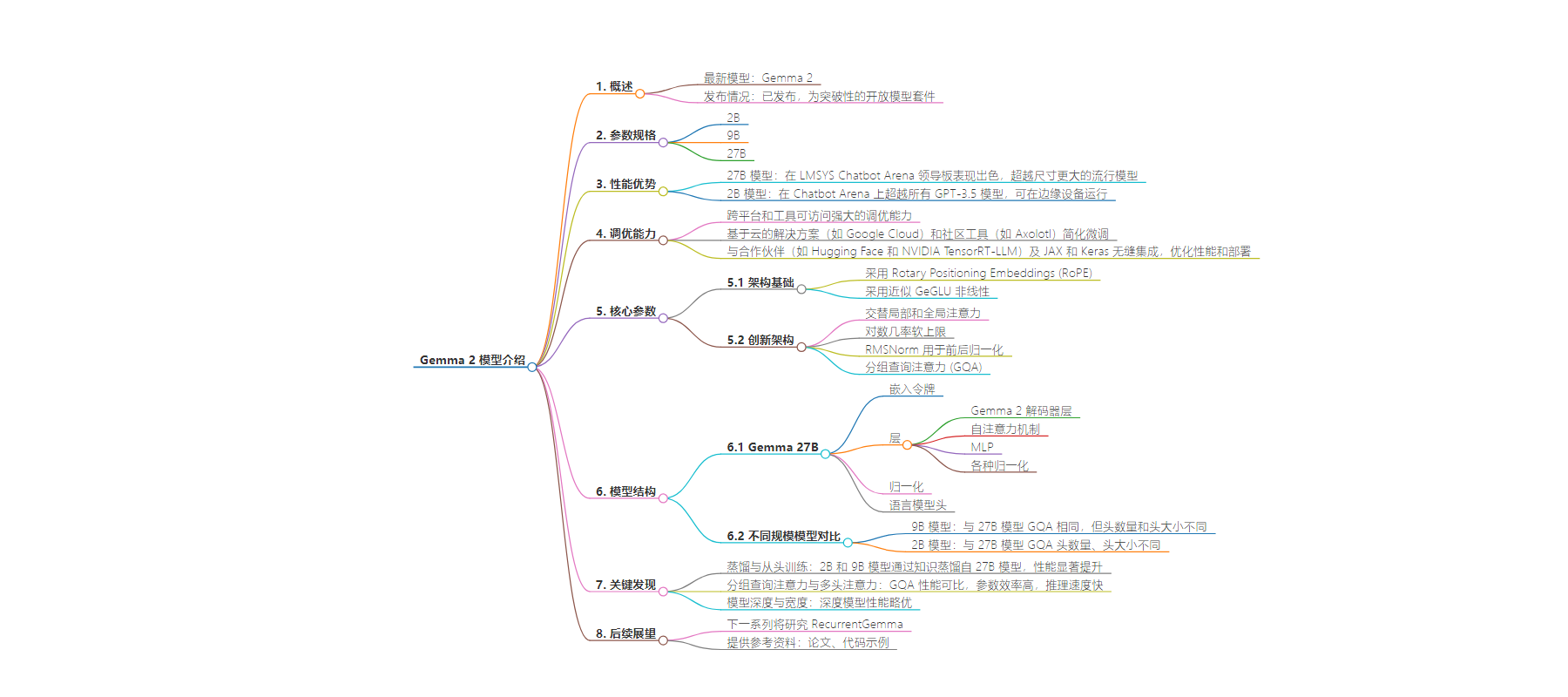包阅导读总结
1. 关键词:Gemma 2、模型架构、性能提升、创新特性、技术发现
2. 总结:本文介绍了 Gemma 2 这一新型开放模型套件,包括其不同参数大小、在 LMSYS 排行榜的表现、跨平台调优能力,还阐述了与初代的相似点及新的架构创新,最后提及了关键技术发现和后续研究方向。
3. 主要内容:
– Gemma 2 概述:
– 近期发布,是突破性的开放模型套件。
– 有 2B、9B 和 27B 等参数大小。
– 性能与优势:
– 27B 模型在 LMSYS 排行榜表现出色。
– 2B 模型在边缘设备上表现优于 GPT-3.5 模型。
– 具备跨平台调优能力。
– 架构创新:
– 包含交替的本地和全局注意力。
– 采用 Logit 软上限。
– 使用 RMSNorm 进行前后归一化。
– 应用分组查询注意力(GQA)。
– 关键发现:
– 2B 和 9B 模型通过知识蒸馏训练有显著性能提升。
– GQA 比多头部注意力有优势。
– 更深的模型比同参数宽度的模型性能略优。
– 后续方向:
– 下一系列将研究基于 Griffin 的 RecurrentGemma。
思维导图:
文章地址:https://developers.googleblog.com/en/gemma-explained-new-in-gemma-2/
文章来源:developers.googleblog.com
作者:Ju-yeong Ji,Ravin Kumar
发布时间:2024/8/22 0:00
语言:英文
总字数:905字
预计阅读时间:4分钟
评分:90分
标签:杰玛 2,AI 架构,分组查询注意力,RMSNorm,logit 软封顶
以下为原文内容
本内容来源于用户推荐转载,旨在分享知识与观点,如有侵权请联系删除 联系邮箱 media@ilingban.com
In the previous post of the Gemma explained series, we discussed the Gemma architecture. In this post, you will explore the latest model, Gemma 2. Let’s get started!
Gemma 2
Recently, we released Gemma 2, our groundbreaking new suite of open models, setting a new standard for performance and accessibility. Available in 2B, 9B, and 27B parameter sizes, Gemma 2 has quickly made its mark. Our 27B model rapidly ascended the LMSYS Chatbot Arena leaderboard, surpassing even popular models more than twice its size in engaging, real-world conversations, establishing itself as one of the highest-ranking and most useful open models. Meanwhile, the Gemma 2 2B model showcases its exceptional conversational AI prowess by outperforming all GPT-3.5 models on the Chatbot Arena at a size runnable on edge devices.
Developers can access robust tuning capabilities with Gemma 2 across platforms and tools. Fine-tuning Gemma 2 is simplified with cloud-based solutions like Google Cloud and community tools like Axolotl. Seamless integration with partners such as Hugging Face and NVIDIA TensorRT-LLM, as well as our JAX and Keras, enables optimization of performance and efficient deployment across diverse hardware configurations.
Here’s the core parameters of the new models:
Key Differences
Gemma 2 shares a similar architectural foundation with the original Gemma models, including the implementation of Rotary Positioning Embeddings (RoPE) and the approximated GeGLU non-linearity. However, it introduces novel architectural innovations that set it apart from its predecessors.
Alternating Local and Global Attention
Instead of considering all words in a text at once, it sometimes focuses on a small window of words (local attention) and sometimes considers all words (global attention). This combination helps the model understand both the immediate context and the overall meaning of the text efficiently.
Logit Soft-Capping
Imagine you are training a model to predict the next word in a sentence. Sometimes, the model might be overly confident about a particular word, even if it’s not the best choice. Logit soft-capping prevents this by limiting how confident the model can be about its predictions, leading to better overall performance.
RMSNorm for Pre and Post-Normalization
Think of this as a way to keep the model’s calculations from becoming too large or too small during training. Just like we might adjust the volume on a speaker to prevent distortion, RMSNorm ensures that the information flowing through the model stays within a reasonable range, leading to more stable and effective training.
Grouped-Query Attention (GQA)
This technique helps the model process information more efficiently, especially when dealing with large amounts of text. It improves upon traditional multi-head attention(MHA) by grouping queries together, enabling faster processing, especially for large models. It’s like dividing a large task into smaller, more manageable chunks, allowing the model to understand the relationships between words faster without sacrificing accuracy.
Gemma 27B
Gemma2ForCausalLM( (model): Gemma2Model( (embed_tokens): Embedding(256000, 4608, padding_idx=0) (layers): ModuleList( (0-45): 46 x Gemma2DecoderLayer( (self_attn): Gemma2SdpaAttention( (q_proj): Linear(in_features=4608, out_features=4096, bias=False) (k_proj): Linear(in_features=4608, out_features=2048, bias=False) (v_proj): Linear(in_features=4608, out_features=2048, bias=False) (o_proj): Linear(in_features=4096, out_features=4608, bias=False) (rotary_emb): Gemma2RotaryEmbedding() ) (mlp): Gemma2MLP( (gate_proj): Linear(in_features=4608, out_features=36864, bias=False) (up_proj): Linear(in_features=4608, out_features=36864, bias=False) (down_proj): Linear(in_features=36864, out_features=4608, bias=False) (act_fn): PytorchGELUTanh() ) (input_layernorm): Gemma2RMSNorm() (post_attention_layernorm): Gemma2RMSNorm() (pre_feedforward_layernorm): Gemma2RMSNorm() (post_feedforward_layernorm): Gemma2RMSNorm() ) ) (norm): Gemma2RMSNorm() ) (lm_head): Linear(in_features=4608, out_features=256000, bias=False))
self_attn
In the self-attention mechanism, Gemma 2 uses Grouped Query Attention (GQA).
k_proj and v_proj share the same head with a size of 128 and 16 heads (128 x 16 = 2048). In contrast, q_proj and o_proj have 32 heads (128 x 32 = 4096) in parallel.
Note that the Gemma 9B model uses the Same GQA but different number of heads(8 for k_proj and v_proj, 16 for q_proj and o_proj) and head size (256)
(self_attn): Gemma2SdpaAttention( (q_proj): Linear(in_features=3584, out_features=4096, bias=False) (k_proj): Linear(in_features=3584, out_features=2048, bias=False) (v_proj): Linear(in_features=3584, out_features=2048, bias=False) (o_proj): Linear(in_features=4096, out_features=3584, bias=False) (rotary_emb): Gemma2RotaryEmbedding() )
The 2B model uses 4 for k_proj and v_proj, 8 for q_proj and o_proj and head size (256)
pre_feedforward_layernorm and post_feedforward_layernorm
Another significant distinction is the inclusion of additional RMSNorm in Gemma 2, which enhances the stability of the training process.
Key Findings
Our technical report provides in-depth details, but here’s a quick summary of Gemma 2’s main findings:
Distillation vs. Training from Scratch:
We trained the 2B and 9B models with knowledge distillation from the larger model (27B).
Distilling knowledge from a larger model, even with an equal number of training tokens, leads to significant performance enhancements.
Grouped Query Attention vs. Multi Head Attention:
Replacing MHA with GQA results in comparable performance while offering parameter efficiency and faster inference times, making GQA the preferred choice.
Model Depth vs. Width:
A deeper model showcases slightly superior performance compared to a wider model with the same parameter count.
What’s Next?
In this article, you learned about Gemma 2, the next generation of Gemma models.
In our next series of posts, you will examine the RecurrentGemma which is an open model based on Griffin.
If you want to delve into the fascinating world of AI and gain insights from the experts who are shaping its development, head over to goo.gle/ai-podcast or search for the show “People of AI Podcast” on any podcast platform.
Stay tuned and thank you for reading!
